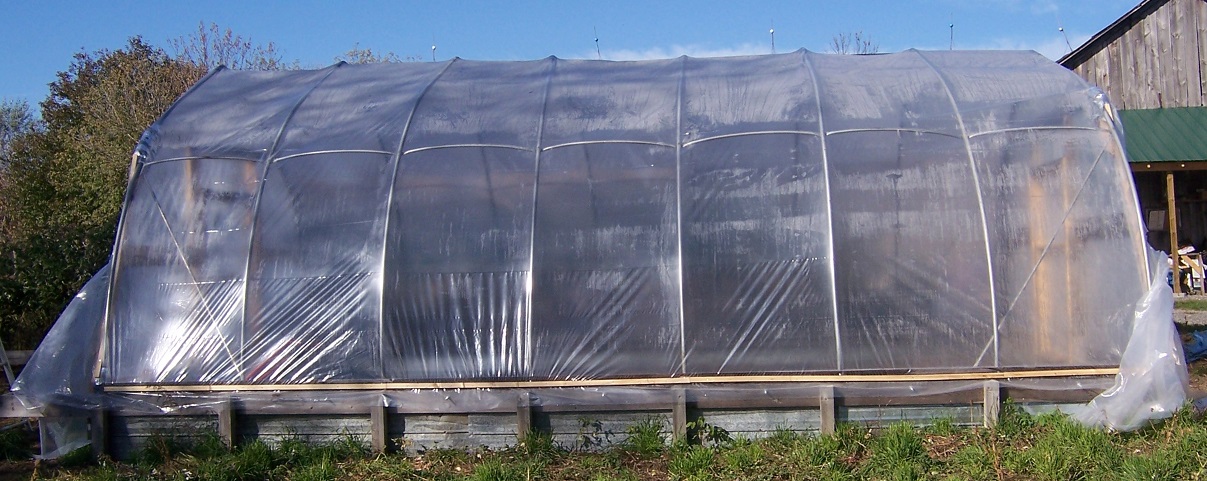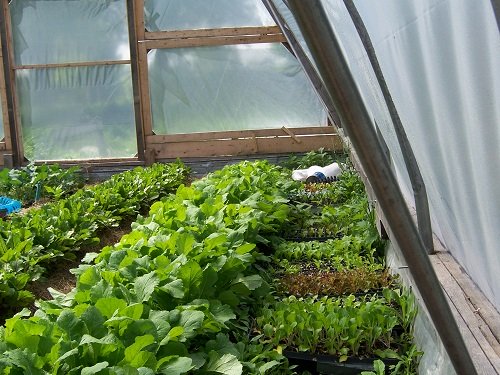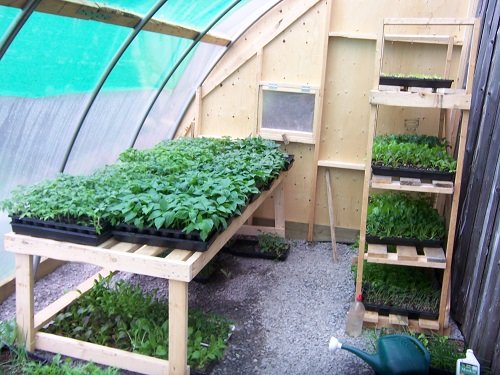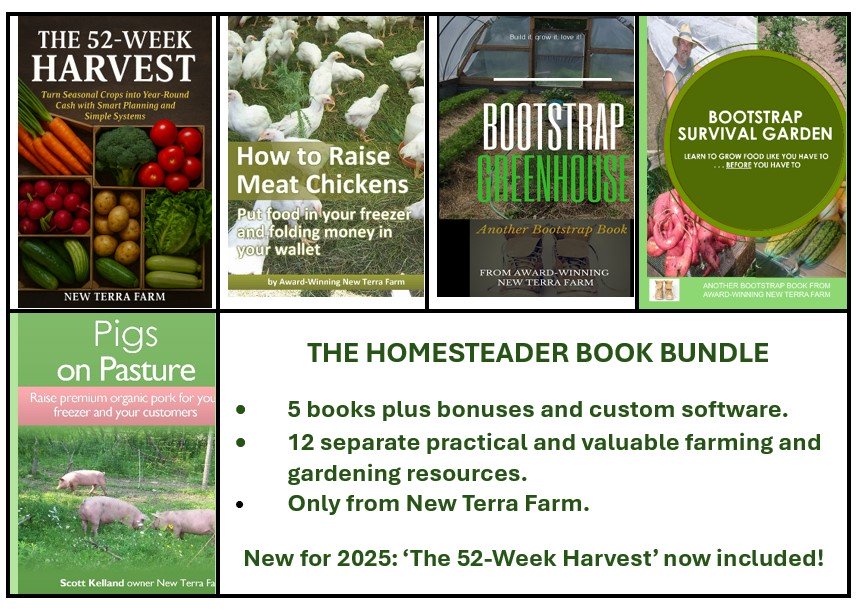Small Scale Greenhouse Growing For The Market Gardener
 I've been small scale greenhouse growing for almost 2 decades I've been small scale greenhouse growing for almost 2 decadesIt’s spring (or nearly) and the young farmer’s fancy turns to thoughts
of small scale greenhouse growing! Well, mine does anyway. When the seed catalogues
come I grab a coffee and start plotting out the season. My small greenhouses
are a big part of that. Pro tip: order your seed early, popular varieties can sell out quickly. Check out this source for organic seed in commercial quantities. Their pelleted carrot seeds are one of my favorites. If you’ve been thinking about setting up a small greenhouse of your own, whether to extend your season, boost your income, or just make the most of your space, this article is for you . You don’t have to be a big farmer to get good use from greenhouses. They can be a game-changer for small growers – just like you What Do I Mean By Small-Scale Greenhouse Growing?
Basically, small scale greenhouse growing is about creating a micro-climate for your plants—providing protection against surprise frosts, flooding rains, and many pests. Size-wise, I consider small greenhouses to be in the 500-1,000 square feet range. My biggest hoop house is just over 500 square feet. The covering could be glass or rigid poly-carbonate, but in this article I’m going to focus on the budget option - a hoop house (high tunnel) covered in poly film. I’ve got 3 poly plastic film covered hoop houses. The plastic sheeting is relatively cheap and good for 5 seasons. But most important is the purpose: your small greenhouse can be used to grow high value crops, extending your season and your income. Whether you’re growing for a farmers' market, local chefs, or direct-to-customer sales, a greenhouse gives you an edge over traditional outdoor growing. . Why Should You Care About Greenhouse Growing?So, why bother investing your time, money, and energy into a greenhouse? Good question. Here’s why it’s worth it: Extended Growing Season. My unheated hoop house adds about a month to each end of my growing season. More season = more harvests = more income. Consistent Quality and Yield. Crops protected by a greenhouse deliver more salable produce. Highly Productive. In a greenhouse you can grow vertically, grow in permanent raised beds, plan smarter, and produce way more in less space. Environmentally Friendly. Greenhouses can actually reduce water use and minimize waste, especially if you use drip irrigation and mainly solar heating, Eliot Coleman once calculated that it took 1/20th the energy to grow a head of lettuce in the cold months in Vermont, as compared to trucking it in from warmer locales. That includes the energy embedded in the poly film covering. Small Scale Greenhouse Growing Step-by-Step1. Structure. We’re going with a poly covered hoop house, which fits most budgets. My hoop houses cost me between $1.50 to $2.50 a square foot, because I’m a barterer and a scrounger. It’s still the cheapest covered space you can build, even if you have to buy new. You can read more about details of my hoop houses construction here. And if you can’t scrounge or barter materials, here’s a good choice for hoop
house kits. They also have a very nice seed starting kit, the trays are sturdy and reusable. 3. Location. Your greenhouse’s location is critical. A poorly chosen site can lead to stunted crops, temperature swings, and poor yields. Key Location Factors:
My main hoop house is located in an open field close to my barn. The field has a crest and slopes gently to the east and west. The hoop house is situated near the peak of the crest, high and dry. The orientation is north-south i.e. the long axis faces east-west. Trees to the east and south, and the barn itself are close enough to provide wind shelter without shading the location. Trees on the border between my fields to the north and west are further away, but also provide a windbreak. A field road goes right to the hoop house, and it’s located close enough to my barn to run power for a ventilation fan and hoses for irrigation. 3. Environmental Controls. Number one is ventilation. Ventilation is essential in a small hoop house to regulate temperature, manage humidity, and ensure proper airflow. Without adequate ventilation, heat and moisture can build up, cooking your plants and encouraging mold and diseases. Natural Ventilation is passive: Open end walls or roll-up sides during warm days to allow hot air to escape and cooler air to enter. My big hoop house has 5 foot wide doors at each end so I can create natural air circulation. Active ventilation uses fans to enhance airflow and keep moisture levels down. My biggest hoop house has a 2 foot square barn fan installed in the south end wall. No fancy control, I plug it in when I want t to run. Growing In Your Small Greenhouse
 Greenhouse fully planted with trays of transplants hardening off on the sides Greenhouse fully planted with trays of transplants hardening off on the sidesThis is the point of small scale greenhouse growing is to produce some valuable crops to make more money! My hoop house is made up into 30” wide beds with 14” paths between. Since my hoop house is 20 feet wide, I can fit 5 rows across. Beds are oriented north-south. After adding any soil amendments and rototilling, I shovel up the beds by hand. The beds are finished with my garden rake, conveniently 14” wide. I also use the rake to smooth the paths, raking excess soil up into the beds. The outside beds, adjacent to the poly walls, are mulched in a thick layer of hay. I use these rows to hold and harden off trays of transplants from my seed starting room before planting them out in the garden. Maintaining Soil Fertility. It's a small footprint, so I can just till in 10 or a dozen wheelbarrow loads of my own composted horse bedding. I use the three-year-old stuff for the greenhouse. I put add down a good one-inch layer on half the greenhouse each year, alternating halves. Peas, been and greens go in the half with compost applied same year. Tomatoes, peppers and the root crops are planted in the half that got compost the year previous. Choose Your Crops To Suit Your Operation And
Your Objectives
 This lean-to is built off the south-facing gable end of one of my outbuildings. This lean-to is built off the south-facing gable end of one of my outbuildings.The main point here is grow what your market wants. I plan for three growing seasons in my greenhouse. In the first season, running from last week of March to last week of June, I grow cold-hardy crops that are popular my local market early in the season This includes beets, carrots, bunching onions, broccoli, radishes, mini-romaine lettuces, and sugar snap peas. The deep greenhouse beds an excellent medium for root crops My second season, running from first week of May to end of September consists of warm weather crops like cherry tomatoes and mini sweet peppers. Those two are consistent good sellers at my market. I grow the cherries up a rope suspended from the greenhouse hoops and cross bars. My fall season repeats the spring, adjusted for shortening days, with crops that will bring me to the end of my market. Work backwards from your first market date to plan your first and second seasons, and from your last market date to plan the third season. Everything is started indoors under lights and transplanted out, except the carrots. Your Action Plan: Ready, Set, Grow!
Go thou forth and grow!
Other Links of Interest to the Small GrowerHere's my curated list of micro-farm equipment for the small grower Diversify, but do it smart. Read this before you start. Farm Side hustles that work in the real world Resources and RecommendationsSave 15% on a selection of farm and garden supplies. Read my Garvee review here More farm-grown reviews of products for the small grower and homesteader Grow for maximum profit Grow the Top Ten Most Profitable Vegetables CSA farms have the highest net income of all market garden models. Bootstrap Market Gardening shows you how to launch one of your own. I would be remiss if I didn't include my Homesteader Book Bundle in this collection of self-sufficiency resources. This is a collection of practical farming and gardening guides, curated specifically for the homesteader or small property owner looking to up their self-sufficiency game. Includes 5 complete books plus bonuses and custom software in one valuable bundle. Get the bundle and save more than 40% of the cost of the individual books. Get it here.
|
See something you like? Share!
Got questions to ask, stories to tell?
Share your organic market gardening question, or comment, or story.
Recent Articles
-
Farm grown reviews of products recommended by New Terra Farm
Dec 04, 25 06:26 AM
Find great farm and garden products in my farm grown reviews -
Best Chicken Coop and Accessories for Small Farms and Homesteads
Nov 30, 25 09:18 AM
Looking for the best chicken coop? Here are the top coops, accessories, nest boxes, and gear to build a safe, productive poultry setup. -
Community Supported Agriculture Marketing Ideas To Sell Out The Season
Nov 05, 25 05:18 AM
Authentic Community Supported Agriculture marketing ideas to grow loyalty, boost sign-ups, and sell out your CSA every year




